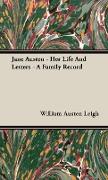- Start
- Jane Austen - Her Life and Letters - A Family Record
Jane Austen - Her Life and Letters - A Family Record
Angebote / Angebote:
HER LIFE AND LETTERS- A FAMILY RECORD by WILLIAM AUSTEN-LEIGH AND RICHARD ARTHUR AUSTEN-LEIGH. originally published in 1913. PREFACE: SINCE 1870-1, when J. E. Austen Leigh l published his Memoir of Jane Austen, considerable additions have been made to the stock of information available for her biographers. Of these fresh sources of knowledge the set of letters from Jane to Cassandra, edited by Lord Brabourne, has been by far the most important. These letters are invaluable as memoires pour servir although they cover only the comparatively rare periods when the two sisters were separated, and although Cassandra purposely destroyed many of the letters likely to prove the most interesting, from a distaste for publicity. Some further correspondence, and many incidents in the careers of two of her brothers, may be read in Jane Austens Sailor Brothers, by J. H. Hubback and Edith C. Hubback while Miss Constance Hill has been able to add several family traditions to the interesting topographical information embodied in her Jane Austen Her Homes and Her Friends, Nor ought we to forget the careful research shown in 1 Father of one of the present writers, and grandfather of the other other biographies of the author., especially that by Mr. Oscar Fay Adams. During the last few years, we have been fortunate enough to be able to add to this store and every existing MS. or tradition preserved by the family, of which we have any knowledge, has been placed at our disposal. It seemed, therefore, to us that the time had come when a more complete chronological account of the novelists life might be laid before the public, whose interest in Jane Austen as we readily acknow ledge has shown no signs of diminishing, either in England or in America. The Memoir must always remain the one first hand account of hen resting on the authority of a nephew who knew her intimately and that of his two sisters. We could not compete with its vivid personal recollections and the last thing we should wish to do, even were it possible, would be to super sede it. We believe, however, that it needs to be supplemented, not only because so much additional material has been brought to light since its publica tion, but also because the account given of their aunt by her nephew and nieces could be given only from their own point of view, while the incidents and characters fall into a somewhat different perspective if the whole is seen from a greater distance. Their knowledge of their aunt was during the last portion of her life, and they knew Her best of all in her last year, when her health was failing and she was living in much seclusion and they were not likely to be the recipients of her inmost confidences on the events and sentiments of her youth. Hence the emotional and romantic side of her nature a very real one has not been dwelt upon. No doubt the Austens were, as a family, unwilling to show their deeper feelings, and the sad end of Janes one romance would naturally tend to intensify this dislike of expression but the feeling was there, and it finally found utterance in her latest work, when, through Anne Elliot, she claimed for women the right of fi loving longest when existence or when hope is gone. 3 Then, again, her nephew and nieces hardly knew how much she had gone into society, or how much, with a certain characteristic aloofness, she had enjoyed it. Bath, either when she was the guest of her uncle and aunt or when she was a resident London, with her brother Henry and his wife, and the rather miscellaneous society which they enjoyed Godmersham, with her brother Edward and his county neighbours in East Kent these had all given her many opportunities of studying the particular types which she blended into her own creations. A third point is the uneventful nature of the authors life, which, as we think, has been a good deal exaggerated...
Folgt in ca. 15 Arbeitstagen
